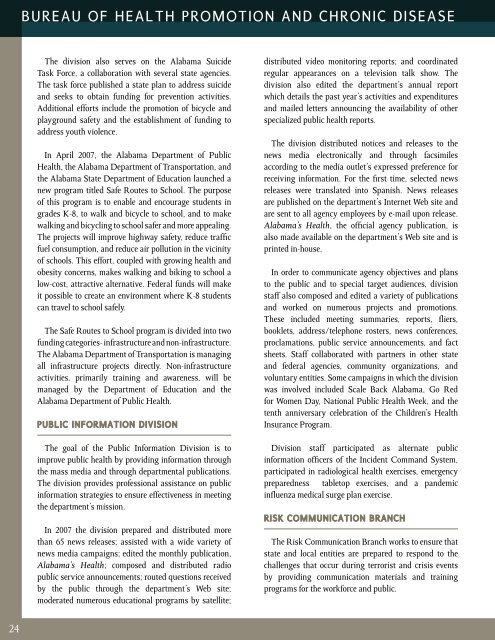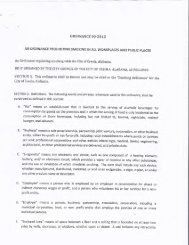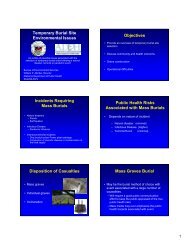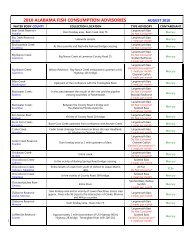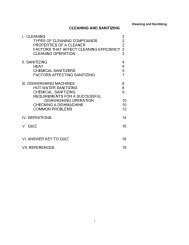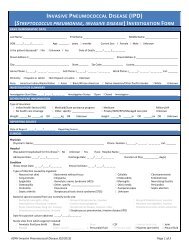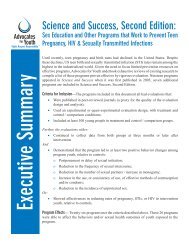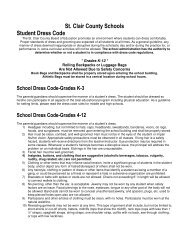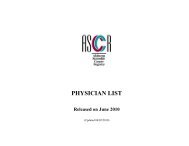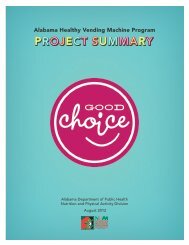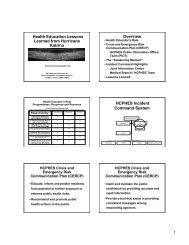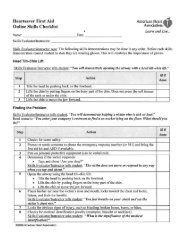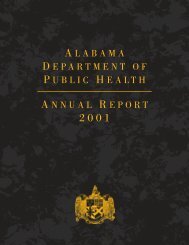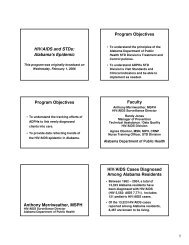2007 - Alabama Department of Public Health
2007 - Alabama Department of Public Health
2007 - Alabama Department of Public Health
Create successful ePaper yourself
Turn your PDF publications into a flip-book with our unique Google optimized e-Paper software.
ureau <strong>of</strong> health promotion and chronic disease<br />
The division also serves on the <strong>Alabama</strong> Suicide<br />
Task Force, a collaboration with several state agencies.<br />
The task force published a state plan to address suicide<br />
and seeks to obtain funding for prevention activities.<br />
Additional efforts include the promotion <strong>of</strong> bicycle and<br />
playground safety and the establishment <strong>of</strong> funding to<br />
address youth violence.<br />
In April <strong>2007</strong>, the <strong>Alabama</strong> <strong>Department</strong> <strong>of</strong> <strong>Public</strong><br />
<strong>Health</strong>, the <strong>Alabama</strong> <strong>Department</strong> <strong>of</strong> Transportation, and<br />
the <strong>Alabama</strong> State <strong>Department</strong> <strong>of</strong> Education launched a<br />
new program titled Safe Routes to School. The purpose<br />
<strong>of</strong> this program is to enable and encourage students in<br />
grades K-8, to walk and bicycle to school, and to make<br />
walking and bicycling to school safer and more appealing.<br />
The projects will improve highway safety, reduce traffic<br />
fuel consumption, and reduce air pollution in the vicinity<br />
<strong>of</strong> schools. This effort, coupled with growing health and<br />
obesity concerns, makes walking and biking to school a<br />
low-cost, attractive alternative. Federal funds will make<br />
it possible to create an environment where K-8 students<br />
can travel to school safely.<br />
The Safe Routes to School program is divided into two<br />
funding categories- infrastructure and non-infrastructure.<br />
The <strong>Alabama</strong> <strong>Department</strong> <strong>of</strong> Transportation is managing<br />
all infrastructure projects directly. Non-infrastructure<br />
activities, primarily training and awareness, will be<br />
managed by the <strong>Department</strong> <strong>of</strong> Education and the<br />
<strong>Alabama</strong> <strong>Department</strong> <strong>of</strong> <strong>Public</strong> <strong>Health</strong>.<br />
<strong>Public</strong> Information division<br />
The goal <strong>of</strong> the <strong>Public</strong> Information Division is to<br />
improve public health by providing information through<br />
the mass media and through departmental publications.<br />
The division provides pr<strong>of</strong>essional assistance on public<br />
information strategies to ensure effectiveness in meeting<br />
the department’s mission.<br />
In <strong>2007</strong> the division prepared and distributed more<br />
than 65 news releases; assisted with a wide variety <strong>of</strong><br />
news media campaigns; edited the monthly publication,<br />
<strong>Alabama</strong>’s <strong>Health</strong>; composed and distributed radio<br />
public service announcements; routed questions received<br />
by the public through the department’s Web site;<br />
moderated numerous educational programs by satellite;<br />
distributed video monitoring reports; and coordinated<br />
regular appearances on a television talk show. The<br />
division also edited the department’s annual report<br />
which details the past year’s activities and expenditures<br />
and mailed letters announcing the availability <strong>of</strong> other<br />
specialized public health reports.<br />
The division distributed notices and releases to the<br />
news media electronically and through facsimiles<br />
according to the media outlet’s expressed preference for<br />
receiving information. For the first time, selected news<br />
releases were translated into Spanish. News releases<br />
are published on the department’s Internet Web site and<br />
are sent to all agency employees by e-mail upon release.<br />
<strong>Alabama</strong>’s <strong>Health</strong>, the <strong>of</strong>ficial agency publication, is<br />
also made available on the department’s Web site and is<br />
printed in-house.<br />
In order to communicate agency objectives and plans<br />
to the public and to special target audiences, division<br />
staff also composed and edited a variety <strong>of</strong> publications<br />
and worked on numerous projects and promotions.<br />
These included meeting summaries, reports, fliers,<br />
booklets, address/telephone rosters, news conferences,<br />
proclamations, public service announcements, and fact<br />
sheets. Staff collaborated with partners in other state<br />
and federal agencies, community organizations, and<br />
voluntary entities. Some campaigns in which the division<br />
was involved included Scale Back <strong>Alabama</strong>, Go Red<br />
for Women Day, National <strong>Public</strong> <strong>Health</strong> Week, and the<br />
tenth anniversary celebration <strong>of</strong> the Children’s <strong>Health</strong><br />
Insurance Program.<br />
Division staff participated as alternate public<br />
information <strong>of</strong>ficers <strong>of</strong> the Incident Command System,<br />
participated in radiological health exercises, emergency<br />
preparedness tabletop exercises, and a pandemic<br />
influenza medical surge plan exercise.<br />
Risk Communication branch<br />
The Risk Communication Branch works to ensure that<br />
state and local entities are prepared to respond to the<br />
challenges that occur during terrorist and crisis events<br />
by providing communication materials and training<br />
programs for the workforce and public.<br />
24


